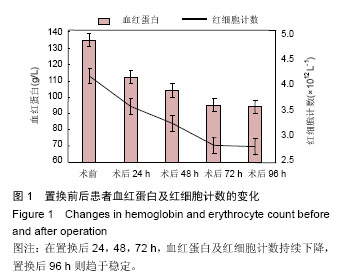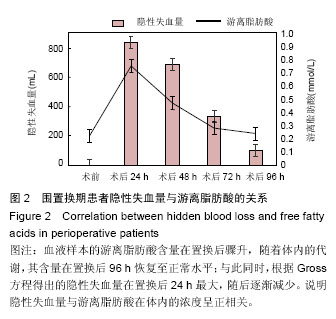| [1] Healy WL, Della Valle CJ, Iorio R, et al. Complications of total knee arthroplasty: standardized list and definitions of the Knee Society. Clin Orthop Relat Res. 2013;471(1): 215-220.
[2] 汪锡龙,尚希福,贺瑞,等.多模式止血方案对减少单膝关节置换术围手术期失血的有效性[J]. 临床骨科杂志, 2015, 18(1): 35-38.
[3] Liu X, Zhang X, Chen Y, et al. Hidden blood loss after total hip arthroplasty. J Arthroplasty. 2011;26(7): 1100-1105. e1.
[4] Sehat KR, Evans R, Newman JH. How much blood is really lost in total knee arthroplasty?: correct blood loss management should take hidden loss into account. Knee. 2000;7(3): 151-155.
[5] 刘志刚,张上上,陈如见,等.全髋关节置换后的隐性失血[J]. 中国组织工程研究, 2013, 17(13): 2305-2312.
[6] Bao N, Zhou L, Cong Y, et al. Free fatty acids are responsible for the hidden blood loss in total hip and knee arthroplasty. Med Hypotheses. 2013;81(1): 104-107.
[7] Schönfeld P, Wojtczak L. Fatty acids as modulators of the cellular production of reactive oxygen species. Free Rad Biol Med. 2008;45(3): 231-241.
[8] Das T, Firdaus SB, Mishra S, et al. Aqueous bark extract of Terminalia arjuna protects against phenylhydrazine induced oxidative damage in goat red blood cell membrane protein, phospholipid asymmetry and structural morphology: a flow cytometric and biochemical analysis. J Phar Res. 2014;8(12): 1790-1804.
[9] Ramkumar KM, Vijayakumar RS, Vanitha P, et al. Protective effect of gallic acid on alloxan-induced oxidative stress and osmotic fragility in rats. Human Exp Toxicol. 2014;33(6): 638-649.
[10] Polash MM, Anam AM, Islam MM, et al. Fat Embolism Syndrome: Our Experience. Banglad Crit Care J. 2013; 1(1): 49-52.
[11] Dixit R, George J, George R, et al. Fat embolism syndrome. Lung India. 2013;30(1): 47-53.
[12] O'Connor MI, Brodersen MP, Feinglass NG, et al. Fat emboli in total knee arthroplasty: a prospective randomized study of computer-assisted navigation vs standard surgical technique. J Arthroplasty. 2010;25(7): 1034-1040.
[13] 袁磊,包倪荣,赵建宁.同一患者分期行关节置换围置换期失血的比较[J].中国组织工程研究,2014, 18(48): 7732-7738.
[14] Akhtar S. Fat embolism. Anesthesiol Clin. 2009;27(3): 533-550.
[15] Neri M, Riezzo I, Dambrosio M, et al. CD61 and fibrinogen immunohistochemical study to improve the post-mortem diagnosis in a fat embolism syndrome clinically demonstrated by transesophageal echocardiography. Forens Sci Int. 2010;202(1): e13-e17.
[16] 顾玉程,李龙云,赵凤芹,等.术中急性肺脂肪栓塞致心搏骤停1例的诊疗分析[J].中华危重病急救医学, 2014, 26(10): 759-760.
[17] 袁涛,丛宇,赵建宁,等.亚油酸与红细胞急性损伤: 人工关节置换后隐性失血的发病机制[J].中国组织工程研究, 2014, 18(48): 7739-7744.
[18] Yuan T, Fan WB, Cong Y, et al. Linoleic acid induces red blood cells and hemoglobin damage via oxidative mechanism. Int J Clin Exp Pathol. 2015;8(5): 5044.
[19] Bao N, Zhou L, Cong Y, et al. Free fatty acids are responsible for the hidden blood loss in total hip and knee arthroplasty. Med Hypothes. 2013;81(1): 104-107.
[20] 邱旭升,陈东阳,徐志宏,等.全膝关节置换术后隐性失血危险因素的分析[J]. 实用骨科杂志, 2012, 18(6): 510-512.
[21] Park JH, Rasouli MR, Mortazavi SM, et al. Predictors of perioperative blood loss in total joint arthroplasty. J Bone Joint Surg. 2013;95(19): 1777-1783.
[22] Tetro AM, Rudan JF. The effects of a pneumatic tourniquet on blood loss in total knee arthroplasty. Can J Surg. 2001;44(1): 33.
[23] Li B, Wen Y, Wu H, et al. The effect of tourniquet use on hidden blood loss in total knee arthroplasty. Int Orthop. 2009;33(5): 1263-1268.
[24] Liu J, Li Y, Cao J, et al. Effects of knee position on blood loss following total knee arthroplasty: a randomized, controlled study. J Orthop Surg Res. 2015;10(1): 69.
[25] Carr IM, Koegelenberg CF, von Groote-Bidlingmaier F, et al. Blood loss during flexible bronchoscopy: a prospective observational study. Respiration. 2012; 84(4): 312-318.
[26] Hazel D, Bern M, Bono J, et al. Effect of Preoperative Autologous Blood Donation Coupled With Fluid Resuscitation on Transfusion Requirements Following Orthopedic Surgery. J Hematol. 2015;4(2): 157-163.
[27] Boswell CA, Ferl GZ, Mundo EE, et al. Effects of anti-VEGF on predicted antibody biodistribution: roles of vascular volume, interstitial volume, and blood flow. PLoS One. 2011;6(3): e17874.
[28] Haien Z, Yong J, Baoan M, et al. Post-operative auto-transfusion in total hip or knee arthroplasty: a meta-analysis of randomized controlled trials. PloS One. 2013;8(1): e55073.
[29] Bisbe E, Moltó L, Arroyo R, et al. Randomized trial comparing ferric carboxymaltose vs oral ferrous glycine sulphate for postoperative anaemia after total knee arthroplasty. Br J Anaesthesia. 2014;113(3): 402-409.
[30] Berra L, Coppadoro A, Yu B, et al. Transfusion of stored autologous blood does not alter reactive hyperemia index in healthy volunteers. Anesthesiology. 2012;117(1): 56.
[31] 石士平,李伟,张伟,等.膝骨性关节炎分级与全膝关节置换后隐性失血[J].中国组织工程研究, 2013,17(35): 6234- 6239.
[32] Liu J, Li Y, Cao J, et al. Effects of knee position on blood loss following total knee arthroplasty: a randomized, controlled study. J Orthop Surg Res. 2015;10(1): 69.
[33] Carocho M, Ferreira IC. A review on antioxidants, prooxidants and related controversy: Natural and synthetic compounds, screening and analysis methodologies and future perspectives. Food Chem Toxicol. 2013; 51: 15-25.
[34] Hopkins J, Tudhope GR. Glutathione peroxidase in human red cells in health and disease. Br J Haematol. 1973;25(5): 563-575.
[35] Sen MA. Progress on GSH-Px and GST. Prog Vet Med. 2008;29(10): 53-56.
[36] Liochev SI. Reactive oxygen species and the free radical theory of aging. Free Rad Biol Med. 2013;60: 1-4.
[37] Lu T, Finkel T. Free radicals and senescence. Exp Cell Res. 2008;314(9): 1918-1922.
[38] Buettner GR. Superoxide dismutase in redox biology: the roles of superoxide and hydrogen peroxide. Anti Cancer Agents Med Chem. 2011;11(4): 341.
[39] Hossain MA, Ismail MR, Uddin MK, et al. Efficacy of ascorbate-glutathione cycle for scavenging H2O2 in two contrasting rice genotypes during salinity stress. Aust J Crop Sci. 2013;7: 1801-1808.
[40] Rifkind JM, Nagababu E. Hemoglobin redox reactions and red blood cell aging. Antiox Redox Signal. 2013; 18(17): 2274-2283.
[41] Gebicka L, Banasiak E. Flavonoids as reductants of ferryl hemoglobin. Acta Biochimica Polonica. 2009; 56(3): 509-513.
[42] Reeder BJ, Wilson MT. The effects of pH on the mechanism of hydrogen peroxide and lipid hydroperoxide consumption by myoglobin: a role for the protonated ferryl species. Free Rad Biol Med. 2001;30(11): 1311-1318. |
.jpg)



.jpg)